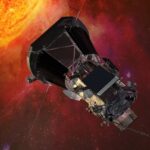In an exhilarating moment for space exploration, NASA’s Parker Solar Probe has successfully completed one of its closest passes ever to the Sun, delivering exciting news that has space scientists on the edge of their seats. Launched back in 2018, this groundbreaking mission continues to provide critical insights into our star, and the recent event marks a new milestone in our understanding of the Sun’s behavior and its vast atmosphere.
A Close Encounter with the Sun
On Christmas Eve 2024, the Parker Solar Probe made history by coming within 6.1 million kilometers of the Sun’s surface. For context, that’s about seven times closer than any previous spacecraft has ever ventured. This unprecedented journey took it deep into the Sun’s corona, the glowing, outermost layer of its atmosphere that becomes visible during a total solar eclipse. By getting so close, the Parker Solar Probe is helping scientists gather valuable data that can only be obtained by venturing into this extreme environment.
What makes this achievement even more remarkable is that the spacecraft didn’t just survive—it passed through the Sun’s atmosphere unscathed. Its metal wings didn’t melt, and the spacecraft’s instruments continued to work flawlessly, sending back data at a speed of 690,000 kilometers per hour. It was a feat that many thought might be impossible, but NASA’s Parker Solar Probe has proven otherwise.
The Importance of this Milestone
This close approach is more than just a technological triumph; it’s a significant step forward in the study of our Sun. The Parker Solar Probe has been designed to answer questions about the Sun’s complex behavior that have puzzled scientists for decades. In particular, the mission focuses on understanding the mechanisms that drive the solar wind, the stream of charged particles that can affect satellite communications, power grids, and even human space missions.
One of the key objectives of the probe’s mission is to study the corona, which is much hotter than the Sun’s surface. The reason why the corona is so much hotter remains a mystery, and this close pass provides an opportunity to collect data that could finally solve this puzzle. As Thierry Dudok de Wit, a researcher involved with the mission, explains, “We’re entering a critical zone of exploration, and this new data is crucial in understanding the Sun’s dynamics.”
A Long Wait for a Big Breakthrough
While the Parker Solar Probe launched back in August 2018, this close encounter didn’t happen overnight. The spacecraft had to make 22 orbits around the Sun to gradually get closer, with each orbit bringing it a little bit nearer to its goal. In fact, the previous pass in September 2024 was still a million kilometers further away. With each flyby, the team gains more insight, and the data being collected is becoming increasingly vital.
In the coming months, the Parker Solar Probe will perform even closer passes, with another approach scheduled for March 2025 and June 2025. These passes are expected to provide even more detailed information, helping scientists piece together the larger puzzle of the Sun’s behavior.
What We Can Learn from the Sun
The data that Parker Solar Probe is sending back could have far-reaching implications, not just for our understanding of the Sun, but also for how we prepare for future space exploration. The Sun’s activities, including solar flares and the solar wind, can have a profound impact on our space-based technology and even our climate. By studying these phenomena up close, scientists can develop better models to predict solar activity and mitigate its potential effects on Earth.
Moreover, the Parker Solar Probe is helping to answer fundamental questions about the solar system’s formation. The Sun is a central piece of the puzzle, and understanding its characteristics and behavior can provide valuable clues about the early solar system and the conditions that gave rise to Earth and the other planets.
A Bright Future Ahead
With every new pass, the Parker Solar Probe is getting closer to unlocking the secrets of the Sun, and scientists are excited about the possibilities. “The pieces are finally coming together,” says one NASA expert, and it’s clear that the data being gathered is poised to transform our understanding of the solar system’s powerhouse.
As the mission progresses, there’s no telling what other surprises the Parker Solar Probe will reveal, but one thing is certain: it’s a game-changer for space science, and we’ve only just begun to scratch the surface.





